
My love letter to Emma Gilchrist
Break out the champagne: Emma’s storied life and leadership in journalism has earned her the...
This week Wet’suwet’en Hereditary Chiefs welcomed a delegation from across the country and beyond to the yintah (territory) for a Peace and Unity Summit. Through the four-day event, the chiefs brought together Indigenous leaders, politicians, conservation groups and others to uplift Indigenous sovereignty, share space and join in solidarity with the Hereditary Chiefs in their opposition to the Coastal GasLink pipeline.
“It’s really heartwarming to see all the people coming together in peace and unity across Canada to maintain the solidarity of the Wet’suwet’en,” Dinï ze’ (Hereditary Chief) Madeek told attendees at the event.
“You make history by being peaceful. By being here, being together, being united, knowing that we all have the same heart,” Dinï ze’ Na’Moks said.
Arrests weren’t part of the plan.
But on the morning of the first day, July 26, more than 30 attendees witnessed a land defender get arrested by the RCMP. They had just travelled the 110 kilometres from Smithers, B.C., to the Gidimt’en camp — a reoccupation of the yintah and village site. They were there to see a feast hall that is being built, meet those living on the land and then go rafting down the Wedzin Kwa (Morice River). As people were starting introductions, a land defender shouted, “someone is getting arrested right now, we need people over at the bridge.”
The guests of the chiefs — which included Cedar George-Parker from the Tsleil-Waututh Nation, several other Indigenous leaders, Sonia Furstenau and Adam Olsen, from the B.C. Green party, Severn Cullis-Suzuki, executive director of the David Suzuki Foundation, and other allies — raced over to see what was happening.
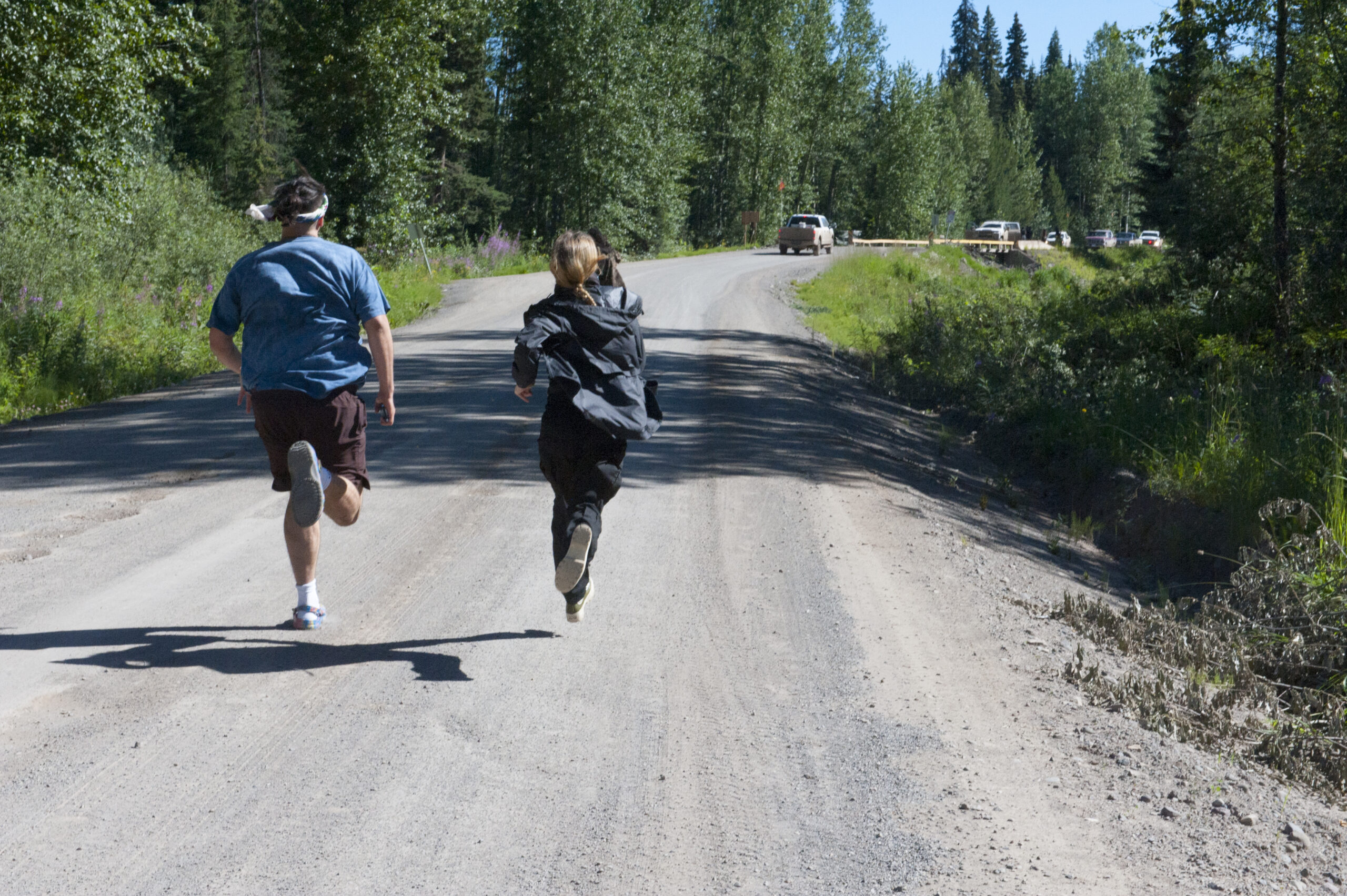
Members of the Community-Industry Response Group, a special unit of the RCMP tasked with policing opposition to resource extraction projects including the Coastal GasLink pipeline, were doing what they described as “routine patrol.” During this patrol they say they saw a vehicle that was the subject of “several complaints from the previous week” and when approached it a passenger continuously blasted an air horn leading to his arrest, according to a statement, released July 28.
As the arrest was happening, some land defenders blocked in the police vehicle, telling the officers inside they were not permitted under Wet’suwet’en law to remove the individual from the territory. With the police suddenly surrounded by supporters and facing a crowd, a standoff commenced.
“He’s being detained for mischief because he blew an air horn,” one land defender told The Narwhal as she pounded on the window of the RCMP vehicle, demanding his release.
The majority of visitors to the territory watched the events unfold as land defenders engaged with the police. Standing on a bridge facing the RCMP vehicle in which the arrested individual was placed, they took pictures, filmed with their phones or simply stood and watched.
The RCMP’s statement described those witnesses as “protesters from the nearby encampment” and said they surrounded the police vehicle.
“We have been here for the last few days as invited guests,” Sonia Furstenau said to the group after reading the statement. “We are not protesters. You are not protestors — this is your land.”
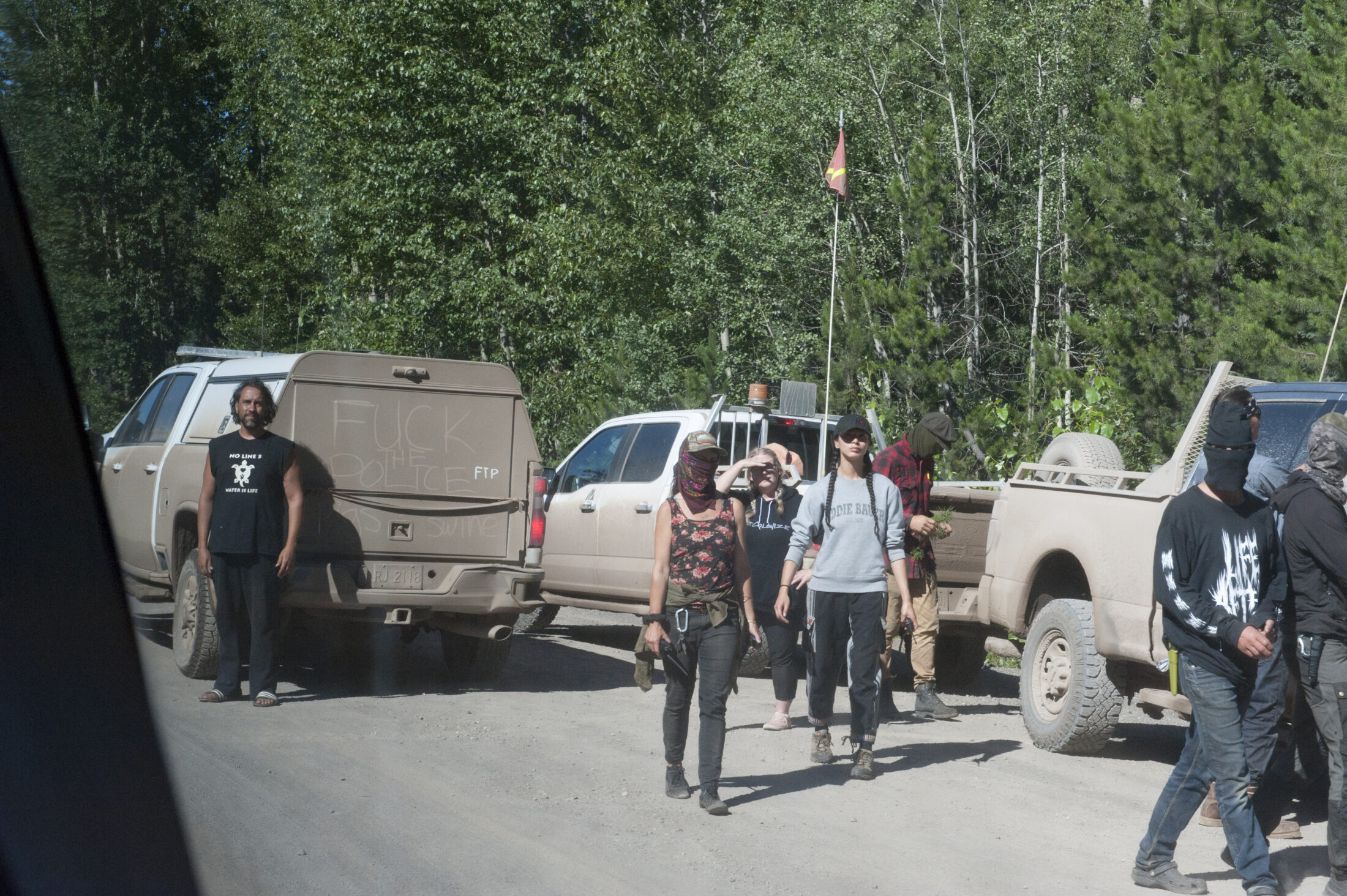
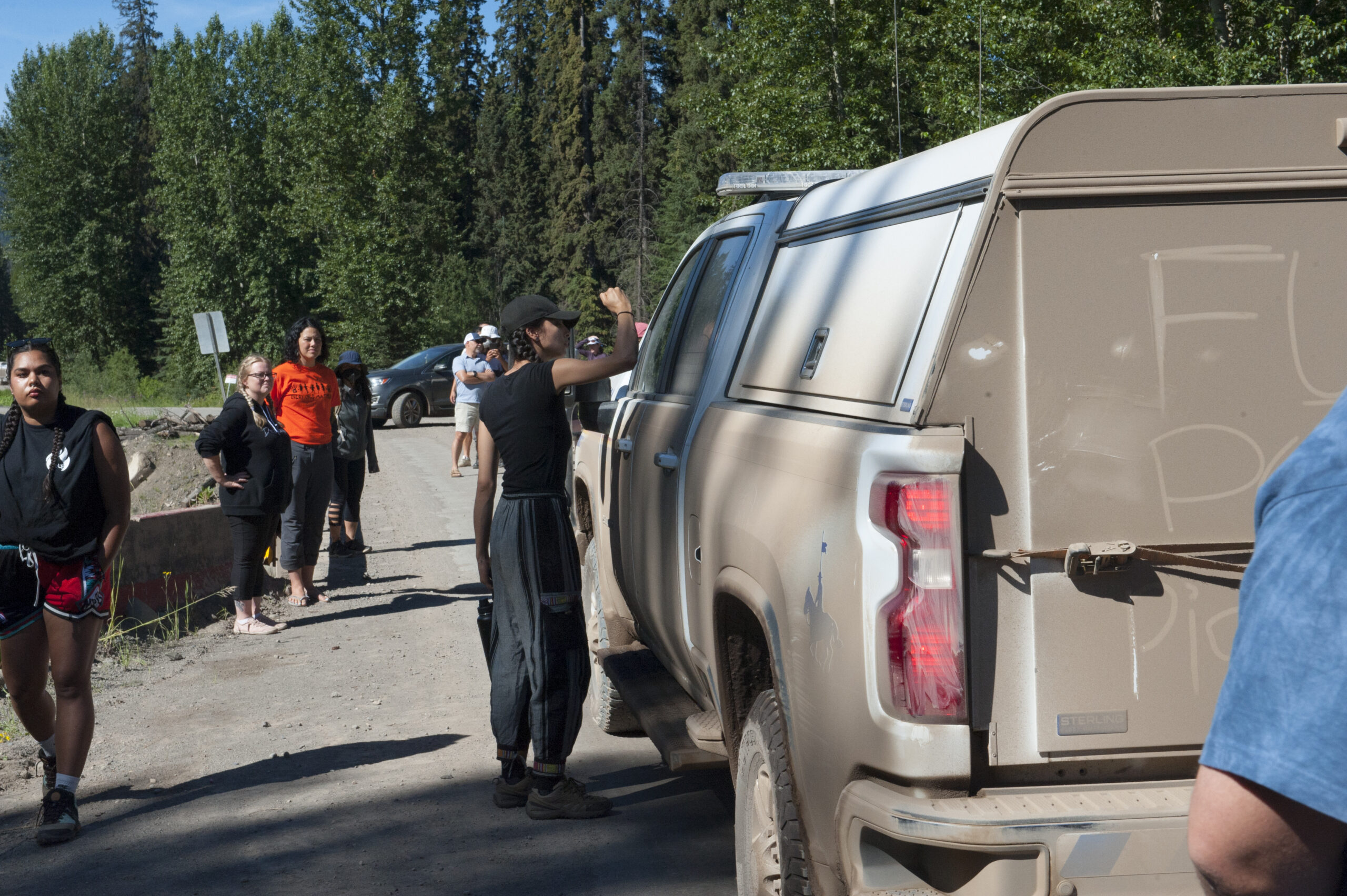

“To immediately be swept up in a clearly violent situation, I think was really good for us to experience as outsiders because that’s just the day-to-day, you know?” Cullis-Suzuki told The Narwhal the following day. For the past several months, RCMP has conducted daily patrols at and around the site, sometimes in the middle of the night. They made several arrests and ticketed people travelling on the dirt and gravel backroads for the likes of illegible licence plates. She said it was evident to everyone present that those who were caught up in the situation didn’t do anything wrong.
“What I’m trying to process is how you don’t really realize the lens with which you’re seeing the news or the images that come to you through screens,” she said. “The narrative is that land defenders are criminals — they’re violent, they’re threatening and police forces are protecting. But this is just existence on the land. This is the right of Indigenous people here in Canada and they’re basically being harassed at great cost to them and their families, on the daily, for exercising their right.”
John Brewer, commander of the Community-Industry Response Group, did not respond to The Narwhal’s request for interview and the RCMP’s media relations team referred The Narwhal to the statement on its website. In that statement, Brewer said his officers handled the situation properly but noted, “situations like these when attempts to intimidate and harass the police while executing their duties will not be tolerated. Violence is criminal and we will take action against anyone participating in these unlawful practices.”
That day, a decision was made for the group who was there to continue to Wedzin Bin (Morice Lake) and go on the rafting trip. But, due to the interactions with police, the road was blocked leaving some participants including Elders and Hereditary Chiefs, unable to get to the camp and share space with the group. Dinï ze’ Madeek told The Narwhal later the Elders started overheating in the vehicles and had to turn back.
Police subsequently arrested a second land defender for mischief and assault — the latter for allegedly “banging a drum near an officer’s head” — and released her with conditions which include not being within five metres of a police vehicle and not drumming within 10 metres of RCMP officers.
Throughout the rest of the Peace and Unity Summit, dignitaries including Grand Chief Stewart Phillip, Amalaxa Louisa Smith, Kukpi7 Judy Wilson and others spoke about Indigenous Rights and sovereignty, injustice, human rights, climate change and more. They also shared their perspectives on the Wet’suwet’en struggle to protect the yintah.
“We need to be relentless in our efforts,” Grand Chief Stewart Phillip said in his opening address. “And we know the enemy’s oil and gas and the emissions that they create which is responsible for global warming. The climate crisis is man-made. Make no mistake about it, it’s man-made.”
“I admire those that have put themselves in harm’s way and have been carted off to jail,” he added. “You’re the heroes of our people, of our generation.”
The Hereditary Chiefs and event organizers wanted the first day of the summit to be a joyful experience centred on the connection to the land and water — what Wet’suwet’en land defenders and their allies have been trying to protect for years.
Once on the river, tensions dissolved. Participants shared stories and laughter and cooled off swimming in the glacier-fed water. Chinook smolt darted around the rafts on the shoreline. The group was taken to an ancient village site and shown culturally modified trees while grazing on wild berries. They drank straight from the Wedzin Kwa.
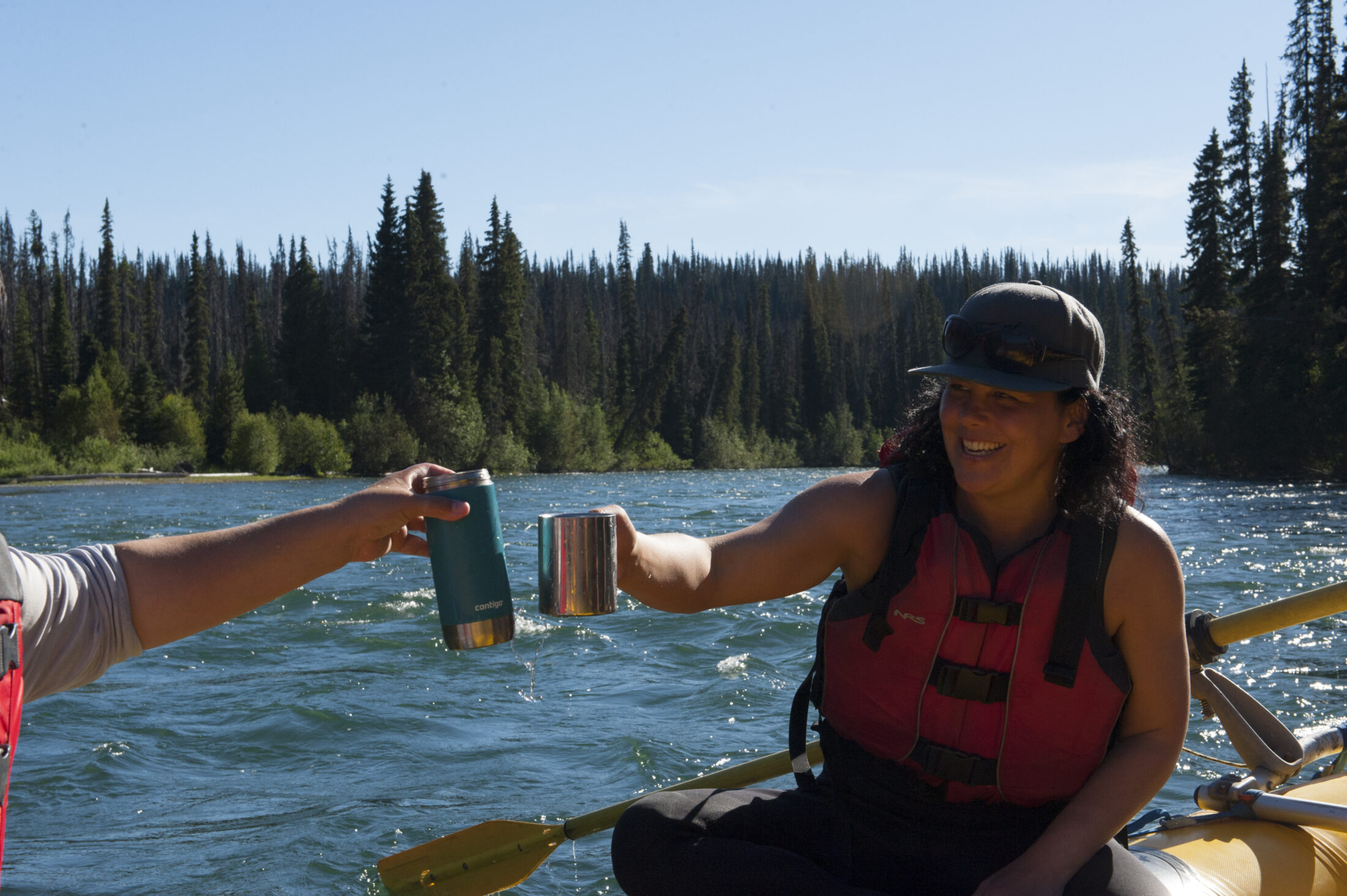


“You can jump into the river with your mouth open,” Simon Stockner, one of the raft guides with Skeena Watershed Conservation Coalition, told those on his boat.
Dinï ze’ Na’Moks told The Narwhal this was part of the plan.
“Once you drink from the Wedzin Kwa, it’s in your DNA forever,” he said. He and others organizing the multi-day Peace and Unity Summit wanted people to feel the land beneath their feet, breathe the air and taste the water directly from the river.
“I saw power yesterday in a couple of different ways,” Adam Olsen (SȾHENEP), Green party representative and member of Tsartlip First Nation (WJOȽEȽP), told The Narwhal on July 27. “The power that we derived from the land and the water, dipping your drinking cup into a pristine river and fearlessly drinking from it.”
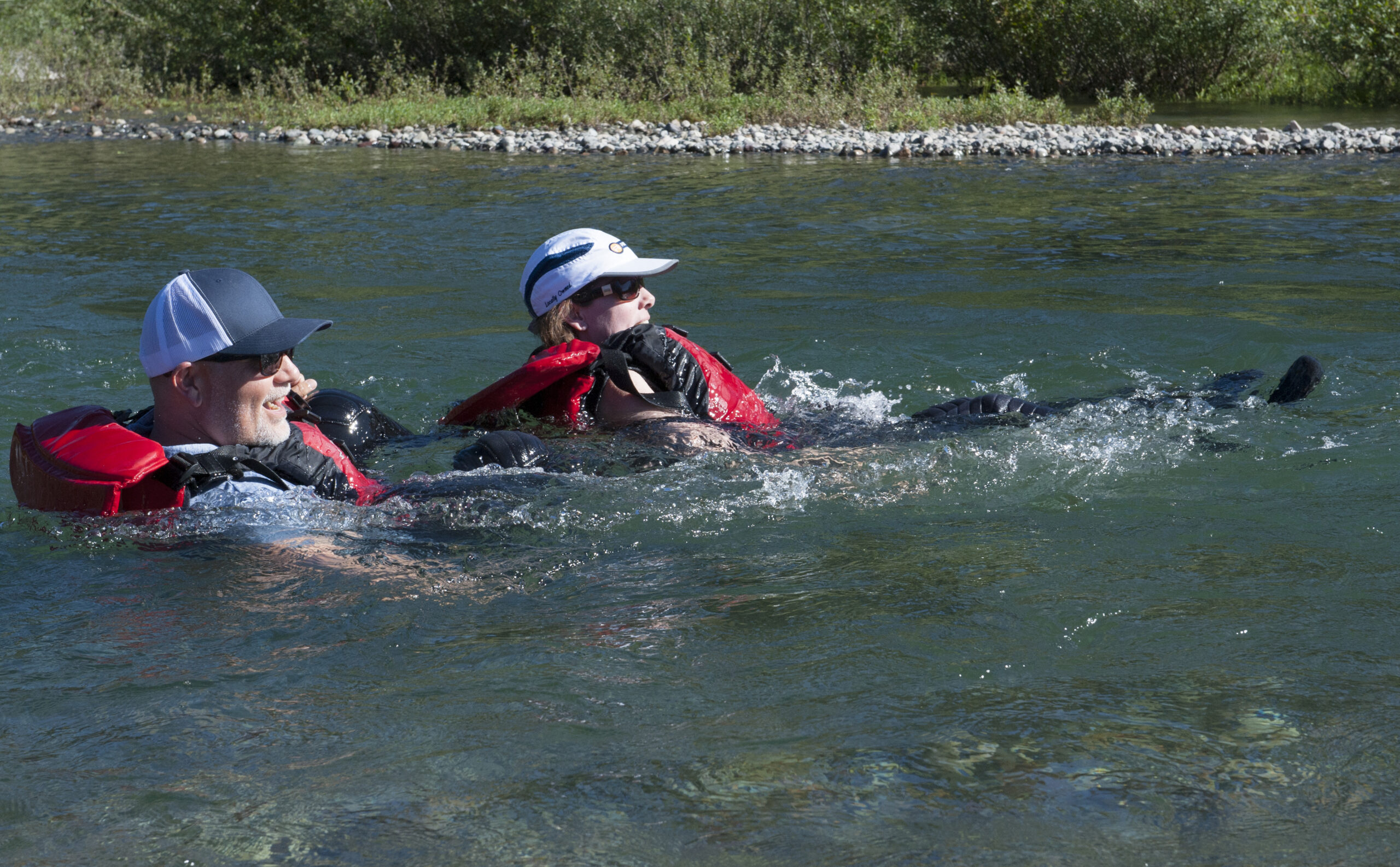
But, he said, he also saw the power that comes from fear when he witnessed the arrest.
“My initial response when I was standing on the side of the road and heard that there was an arrest going down, I thought, wow, it’s like a peacock fanning its feathers,” he said. “In order for that fear-based power to be of any threat whatsoever, it’s got to be exercised and they were exercising it yesterday in front of all of us, just to show us who’s boss.”
“But really it was very clear that the pureness of the power derived from the land and the water is far superior,” he continued. “And it’s only a show of force that is being demonstrated to protect the interests of resource extraction.”
Later in the day, the group stopped for a snack and a swim. The water was icy but refreshing under the hot sun.
Before continuing the trip, Brian Huntington, lead guide and co-founder of Skeena Watershed Conservation Coalition, gathered everyone to say a few words. Huntington is a settler living on Gitxsan territory who was adopted into Wilp Gwininitxw in the Gitanmaxx feast hall in 2007 and given the name Ts’uup Lak’insxw. Dinï ze’ Na’Moks and Sleydo’ Molly Wickham asked him to guide the group and share the knowledge that they had shared with him over the years.
He told the group that the next stop was the site where Coastal GasLink is preparing to drill and lay its pipeline under the river. The pipeline, which is owned by Calgary-based TC Energy, recently revealed its estimated costs have skyrocketed from its previous $6.6 billion to $11.2 billion.
Huntington gently explained the starkness of the contrast between the river and the worksite and said this moment together would help prepare everyone to bear witness.
Travis Pete, one of the guides and a member of the Gidimt’en Clan, invited Cedar George-Parker, from the Tsleil-Waututh First Nation, to sing a song. His booming voice and the constant bubbling of the river blanketed the group and the mood became sombre and reverent.
At the drill site, a surreal scene unfolded as members of the group were met with private security behind barbed wire fences, drones flying overhead, the heat from the sun rippling off concrete. One security worker, as he filmed the group, talked about the B.C. Supreme Court injunction issued against anyone opposing the pipeline project.



“It was interesting to see the response to 30 people coming up from a river in wetsuits and life jackets,” Olsen said. “The response was drones and repeated canned messages and video cameras.”
“The money, the anger, the violence is just so over the top,” Cullis-Suzuki said. “It’s just so clearly evil.”
The raft trip ended at the Unist’ot’en healing centre, where matriarchs, chiefs and land defenders were arrested in 2019 under the terms of the injunction.
Welcomed with a song by some of the women who were arrested that year, including Tsake ze’ Howilhkat Freda Huson and Karla Tait, the group was served herring roe on kelp and salmon, washed down with more water from the river.
“It was an amazing way to end the day,” Cullis-Suzuki said. “To end with these warrior women who are warriors for peace and healing. They have been framed as violent criminals on the outskirts of society.”
Huson recently received international recognition, winning the Stockholm-based Right Livelihood award “for her fearless dedication to reclaiming her people’s culture and defending their land against disastrous pipeline projects.”
Cullis-Suzuki said it’s an apt illustration of how Canada treats Indigenous people.
“It shows how Canada might see these leaders as eco-terrorists but outside countries — more advanced countries — recognize that these are leaders that are fighting for intergenerational justice and human rights.”
Throughout the event, speaker after speaker talked about how their spirits were lifted by coming together and sharing space and feeling the strength of Indigenous leadership. As the event came to a close on July 28, Dinï ze’ Na’Moks summarized and thanked everyone for coming.
“Let that violence come at us — that is now our life. But you know what? We will not react with violence. We will not stoop to their level. We are Wet’suwet’en and we will remain because we have that love for the land, because we have that love for humanity, because we have that love for the future. It’s a fact: we can change the world together.”
Get the inside scoop on The Narwhal’s environment and climate reporting by signing up for our free newsletter. On a warm September evening nearly 15...
Continue reading
Break out the champagne: Emma’s storied life and leadership in journalism has earned her the...

How can we limit damage from disasters like the 2024 Toronto floods? In this explainer...

From disappearing ice roads to reappearing buffalo, our stories explained the wonder and challenges of...
